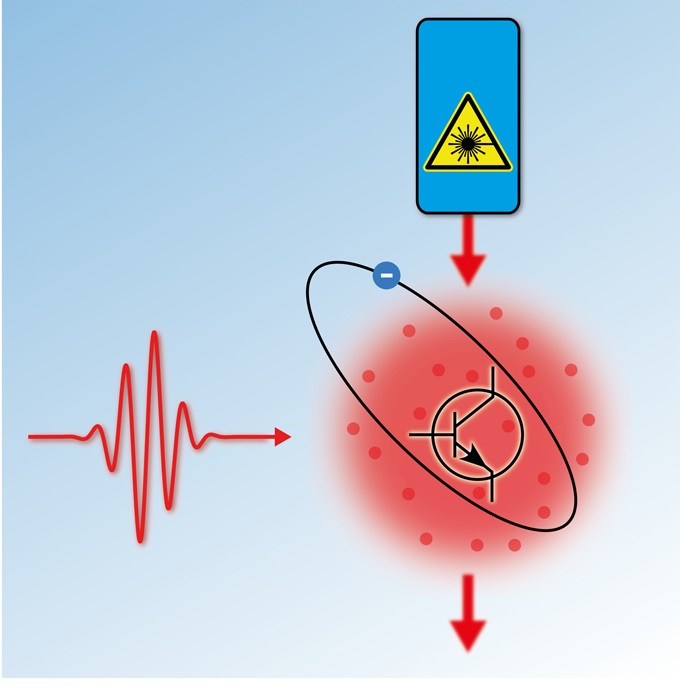28 July 2014
Data transmission over long distances usually utilizes optical techniques via glass fibres – this ensures high speed transmission combined with low power dissipation of the signal. For quite some years possibilities have been explored how to go one step further and perform all-optical data processing, with optical transistors and optical logic gates. In particular in the case of quantum information this option would be highly recommendable as the information is often stored in faint light pulses which – at the ultimate limit – contain a single photon only. A team around Professor Gerhard Rempe, Leader of the Quantum Dynamics Division and Director at the Max Planck Institute of Quantum Optics, has now made a kind of optical transistor using a cloud of ultracold rubidium atoms. With this new device they observed a twentyfold amplification of signal variations at the one-photon level (PRL, 28 July 2014).
The gain of a transistor describes what effect a small change of the input signal has on the output signal. A significant amount of gain is the precondition for distributing the output signal to the input ports of several transistors without signal attenuation, setting the ground for building complex digital switching circuits.
In the case of an optical transistor the input signal is a weak light pulse, called gate pulse, which modifies the transparency of a “medium” for a second pulse, called target pulse. In the experiment described here the medium consists of a cloud of about 150 000 rubidium atoms, kept in an optical dipole trap which is generated by two crossed laser beams. At temperatures of about 0.30 micro-Kelvin (this is just above absolute zero, zero Kelvin correspond to minus 273 degrees Celsius) the cloud can be held in place for several seconds. The effect of “electromagnetically induced transparency” (EIT), in which a control laser modifies the interaction of a faint light pulse with the medium, makes the atomic cloud transparent for light pulses of certain frequencies.
The atomic cloud is irradiated with two light pulses of the same colour (795 nm), separated in time by two microseconds. The first gate pulse is extremely weak, containing less than one photon on average. In combination with the applied control laser it brings one atom in the cloud into a highly excited Rydberg state. As in this state one of the outer electrons orbits at a large distance from the nucleus, this single excitation has a long-range effect: by the mere presence of the Rydberg atom the corresponding energy levels of all other atoms in the cloud are slightly shifted. When the second target pulse hits the cloud, its colour does not match the EIT conditions anymore. That is why the target pulse is blocked by the atoms.
A couple of months ago the team of Prof. Rempe has demonstrated that it is possible to switch the transmission properties of a cloud of rubidium atoms with single photons (PRL, Feb. 18th, 2014). However, this effect was achieved under severe limitations concerning duration as well as intensity of the target pulses.
“In the present experiment we have changed a few things, most importantly, we use control lasers with different wavelengths for gate and target pulses.”, Dr. Stephan Dürr, leading scientist at the experiment, points out. “That way we avoid that the target pulse couples to the Rydberg excitation and retrieves the gate pulse, even for long durations of the target pulse.” Furthermore, different Rydberg states were chosen that give rise to a Förster resonance at which the Rydberg atoms interact with each other even more strongly than they usually would. “The Förster-resonance enhances the effect of the Rydberg blockade which is the true mechanism that prevents the target pulse from traversing the atomic cloud”, Daniel Tiarks, doctoral candidate at the experiment, explains. “Furthermore, with the principle quantum numbers of the chosen Rydberg states we get a smaller effect of self-blockade of the photons in the target pulse, another obstruction that we had to deal with in our previous experiment. With all these measures we were able to increase the duration of the target pulse by two orders of magnitude, up to 200 microseconds.”
By comparing the intensities of the outgoing target pulses with and without a preceding gate pulse (a single photon), the reduction of the target signal was determined. “Right at the Förster-resonance we observe a reduction of 20 photons.”, Stephan Dürr says. “This effect should make it possible – at least in principle – to cascade such transistors in order to solve complex computational tasks. In addition, the present experiment demonstrates a new and non-destructive method for the detection of Rydberg excitations. Because of the high amplification we can reveal whether a single Rydberg excitation has been created in the atomic cloud in a single shot.” Olivia Meyer-Streng
Original publication:
Daniel Tiarks, Simon Baur, Katharina Schneider, Stephan Dürr and Gerhard Rempe
Single-Photon Transistor using a Förster-Resonance
Physical Review Letters, 28 July 2014















